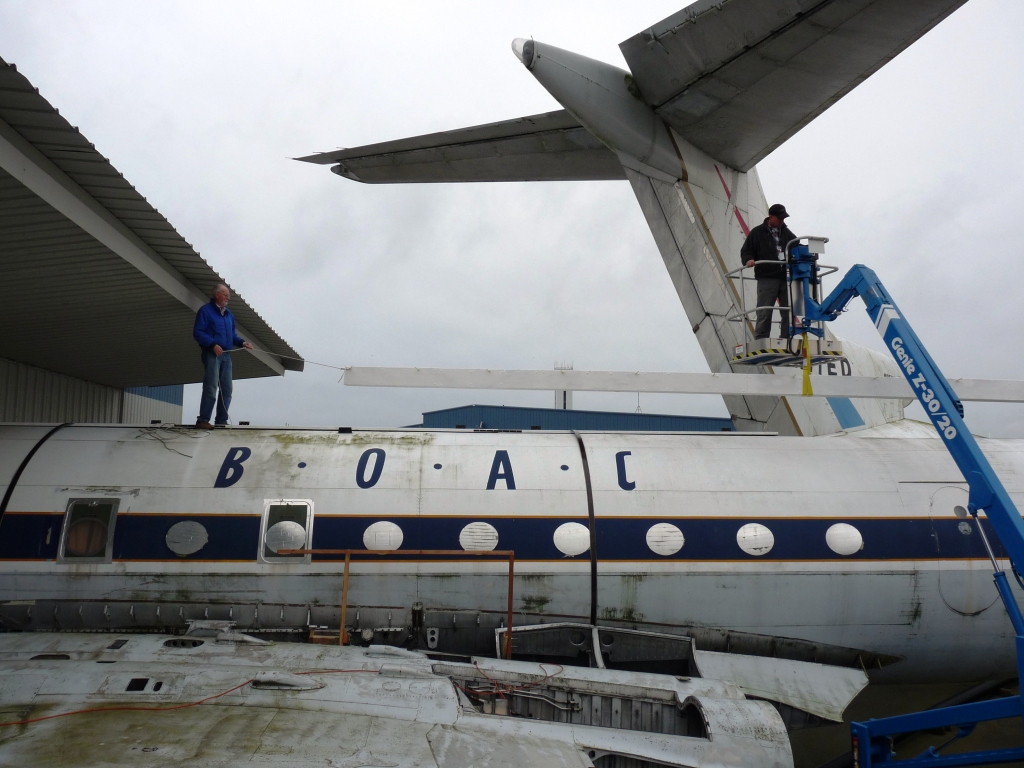Comet Mk4C Restoration News
The First Intercontinental Jet Airliner
"Dedicated to restoration of the first Mk4C and the last complete de Havilland Comet in North America"
From the Desk of Bob Hood ~ Comet Progress Update
There was a great deal of progress in 2010.
Interior work focused on the aft passenger cockpit. In that area, the most visible advance was installation of all but two of the tourist class passenger seats. Less noticeable, but very important to the volunteers, was the installation of a residential furnace under the floor, which kept the space warm enough to allow us to work on it for the entire winter.

While the forward passenger cabin, toilet, and cockpit are almost exact restorations of our ship’s appearance when it first flew at Hatfield in 1959, we decided the aft passenger cabin should be modified to give visitors to the ‘First Jet Airliner’ exhibit an introduction to some of deHavilland’s creative designs and the innovative way DH engineers dealt with the much more difficult environment at 40,000 feet --- about three miles higher than previous piston airliner operations. In this cabin, an acrylic window shows the very strong structure around emergency exits to reinforce against any chance of fatigue failure at the exit’s corners --- due to the maximum pressure differential of 8.25 psi. Another acrylic panel exhibits the electrical connections for the under carpet heater ‘blanket’. --- to deal with the –75 deg F outside air temperature. A set of very thick set of acrylic floor panel illustrates internal details of the ‘fly-by-hydraulics’ aileron control bay, --- showing its many layers of redundancy. Finally, a fourth window reveals the innovative use of ‘Coanda effect’ to control airflow from heater ducts above the center aisle to the space between outer hull insulation and inner cabin finish panels, thence to the cabin itself via expanded metal grillwork at the outboard passenger’s ankle height
Aft of this passenger compartment, three galley units are being installed, with the work about 85% complete. The aft toilets, including complete restoration of the bi-fold doors, have been done, with installation of floor panels and previously restored toilets required reach completion. The aft “Wardrobe” storage area is ¼ complete.
We are deeply aware of the need to preserve as well as restore the last complete Comet in our hemisphere. In late 2010, we were alarmed to discover that both wing bottom skins were rapidly growing areas of penetrating corrosion, which threatened the structural integrity of both wings.
This type of degradation has damaged almost all Comets stored outside. For our aircraft, aft fuselage corrosion has been arrested for 12 years by flooding the area with dry air from a Munters de-humidifier. Many areas in the aft belly have shown practically zero corrosion growth since dry air was introduced.
To preserve the wing structures, we will string cables from wingtip to wingtip, and “bag” both wings to protect them from Puget Sound’s high humidity. A cable support system, located by beams over the top of the fuselage hull and two pannier tanks has been installed. Next, we will mount the cables themselves. With them in place, an impervious plastic barrier will wrap the wings. Dehumidified air (at about 20% relative humidity) will then be pumped into the space surrounding both wings.

When this part of the restoration project is complete, we will have protected most Comet structural components from the weather: The nose and empennage parts, with all external flight surfaces, will be in the Paine Field hangar, while the aft fuselage will be flooded with dehumidified air.
Some of the cable mount components are shown below:

John Blum with pannier tank beam support platforms

Port wing with wingtip cable support system and pannier beam support platform in place

The scale of the cable support beams is shown during their assembly in the hangar

Gary Hopper attaching polyolefin carpet to protect wing skins from abrasion

John Blum and Bob Hood locating hull top beam on its tie-down base
When available time and weather permit, compartment and flight control panel work continues in the restoration hangar.